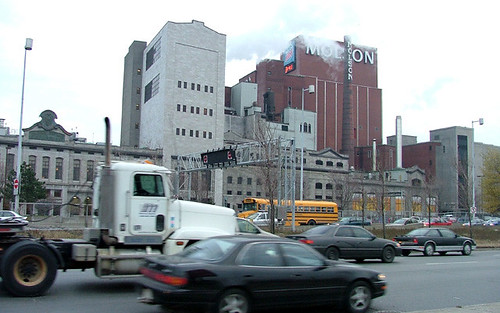The snow has mostly melted and the temperature has climbed above the freezing mark — what to do? Protest, of course.
Tomorrow, east end residents opposed to the Notre Dame highway project will take to the streets in a “grand tintamarre” that aims to catch the attention of the muncipal and provincial officials who want to transform the eastern portion of Notre Dame Street into an expressway. They’ve already earned the support of 24 well-known academics, politicians and activists, including architect Phillys Lambert and Hochelaga MNA Louise Harel, who signed a declaration in support of public transit projects instead of the Notre Dame expansion.
Park Avenue’s Urban Ecology Centre, which was born in the fight against the Cité Concordia project that would have razed most of the McGill Ghetto, has also come out against the Notre Dame scheme. Yesterday, it issued a statement outlining its concerns:
Un tel aménagement contribuera à accroître significativement la capacité du réseau routier montréalais et amènera 50 000 nouveaux véhicules vers le centre‐ville. Il s’agit d’une aberration inconcevable en regard de nos connaissances sur les effets néfastes d’une forte circulation motorisée (pollution de l’air, émissions de gaz à effet de serre, impacts sur la santé de la population riveraine des grandes artères, risques dʹaccidents dans les quartiers qui doivent absorber le surplus de circulation, etc.). En outre, toutes les études démontrent que les effets positifs recherchés par une augmentation de la capacité routière, principalement la réduction de la congestion, ne sont que de très courte durée puisqu’ils sont annulés, en quelques années, par le trafic induit par l’offre accrue.
The impact of increased traffic and pollution seem to be the highway project’s greatest drawbacks, but what is truly frustrating about the plan is that it feels like a half-baked compromise between provincial transport officials, who wanted a full-fledged expressway, and city officials, who wanted an “urban boulevard” that would be more integrated into east end neighbourhoods. It seems likely that, even with an increase of capacity, the new highway will quickly become congested, especially as the port—to which Notre-Dame is the main link—aims to increase its cargo traffic. What will happen then?
Tomorrow’s march will start at 1:30pm outside Papineau metro before heading down Ste. Catherine Street to Morgan Park and the Maisonneuve Market.


4 comments
Why aren’t they marching on Notre Dame?
Yeah i don’t understand that, its a vibrant urban area with beautiful beaches on the river and parks, its residential and commercial assets would have been a great support for this cause…
so what you’re saying is that since there is “nothing” alongside the river in that area, let’s just not develop it?
don’t you *see* how you think in the wrong way?
Example: in the 70’s, the city of Paris decided to put a highway alongside the Seine river. what happened? the environment was so much destroyed by traffic (noise, noise, air pollution, noise, awful thing to look at, noise) that people abandoned their river. as a result, pollution in there gets worse since people don’t care.
Opposite example: Bordeaux has been taking to huge urbanistic transformations in the last decade -renovation of old houses, tramways, pedestrianization of large parts of the city center, new development of the riverside with shops, sunday morning markets, parks and bicycle tracks, etc. etc. what’s the result, besides an unknown popularity of the city itself? it was recognized as part of UNESCO’s “World Heritage” or whatever it is called in English.
and if you need another example -one of a city that could resemble Montreal in some aspects-, take Vienna: tramways (ok, they’re old, but they’re there), trolleybusses, and most important: THE WHOLE CITY CENTER IS PEDESTRIANIZED.
but maybe you prefer tourists to keep an image of Montreal as a car-overwhelmed city -just like in the Third world- where highways get right into the city center, a city that keeps inforcing old recipes that are obviously doomed -look at the price of the oil barrel and PLEASE think again.
why do you even come and read this kind of blogs when thinking like this? live in Cairo or Detroit or wherever you’ll find as many cars as you want, but stop pretending Montreal’s future involves more space for suburbians’ cars, and less for its own inhabitants.
They are crazy to want to make this an expressway. There is nothing more outdated. The odd part is, we have just/continue to deal with correcting the scars made by the Ville-Marie between roughly University to St Denis.
I would much rather keep the boulevard as is than make it an expressway. Take a look at any South American capital or even Paris for that matter – you can have broad 8 or 10 lane boulevards that blend into the urban fabric. It is a matter of vision, and creativity; a trench expressway is an easy solution but one with regreatable consequences.
Do you have any idea how New Yorkers for example, thank their lucky stars that the West Side Highway was NOT turned into an expressway. It’s a question of better traffic flow design and landscaping. Landscaping, landscaping, landscaping.